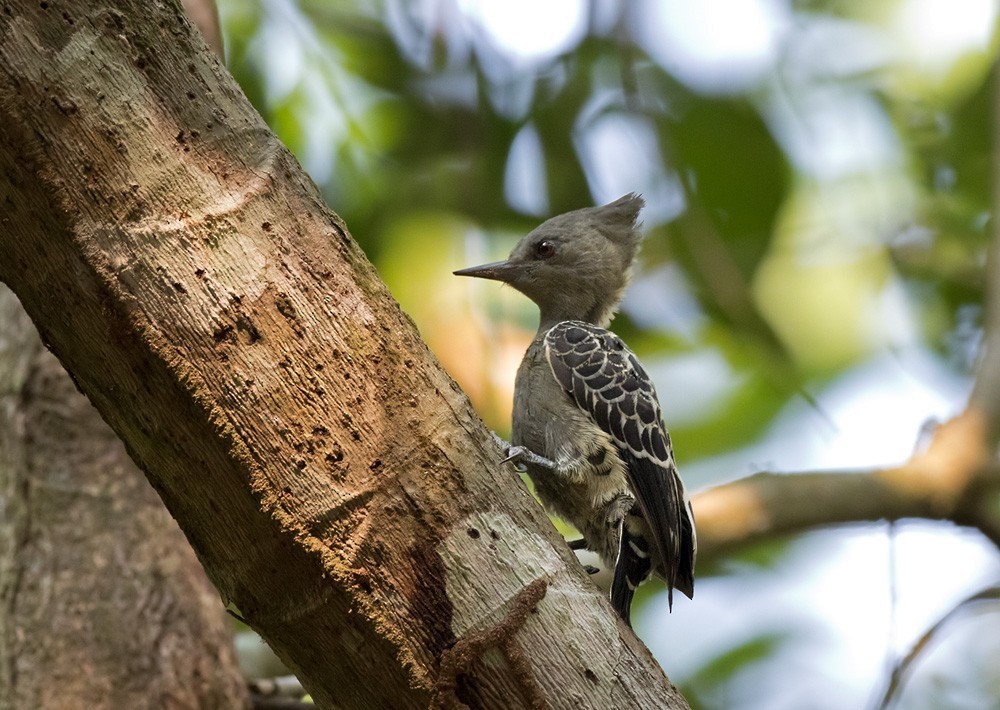Grey-and-buff Woodpecker
A species of Large-crested Woodpeckers Scientific name : Hemicircus concretus Genus : Large-crested Woodpeckers
Grey-and-buff Woodpecker, A species of Large-crested Woodpeckers
Botanical name: Hemicircus concretus
Genus: Large-crested Woodpeckers
Content
Description General Info
 Photo By Lars Petersson
Photo By Lars Petersson Description
The species has a plump body and short rounded tail, and grows to a length of about 13.5 cm (5.3 in). The head appears large because of the slender neck and the large, cone-shaped crest. The head is largely grey, with a fine white, wavy line running from the cheek to the mantle. In males the forehead is red and the crest grey, while in females, both are grey. Body upper parts and wings are blackish, the feathers being edged with white or buff giving a scalloped effect. Underparts are grey, the tail and underwing dark, and the legs are grey or brown. The beak is long, slender and grey with a black tip, and the iris is chestnut. A gland of unknown function is on the back, the secretions from which sometimes stain the white rump. 
Size
14 cm
Nest Placement
Cavity
Feeding Habits
Grey-and-buff Woodpecker primarily consumes insects and occasionally fruits. It forages alone or in groups, joining mixed-species flocks, gleaning food from treetops, bark, and foliage, also pecking and probing. Exhibits rapid movement and flexibility, often flying long distances to forage.
Habitat
The grey-and-buff Woodpecker typically inhabits broadleaf evergreen forests, predominantly in secondary growth areas, as well as edges of forests. This species shows adaptability, venturing into plantations, gardens, and sometimes wooded areas within human settlements. They are found across various regions of Southeast Asia and have a particular affinity for habitats that include bamboo.
Dite type
Insectivorous
General Info
Feeding Habits
Bird food type
Behavior
The grey-and-buff woodpecker is usually seen singly or in pairs, but sometimes occurs in mixed species flocks foraging in the canopy. It mainly feeds by gleaning rather than by drilling into the wood, the diet consisting of insects and fruit, including mistletoe (Loranthus) berries. The birds roost communally at night in shallow holes they excavate near each other in dead wood. Nesting takes place in deeper holes or crevices, the breeding season being between December and July. 
Distribution Area
This woodpecker is native to tropical southeastern Asia. Its range extends from southern Myanmar and peninsular Thailand and Malaysia, to Sumatra and Borneo. It is a resident species found in lowland and mid-elevation evergreen rainforests, particularly clearings and forest edges, also in plantations, bamboo thickets, cleared areas, wooded urban areas and cultivated land. 
Species Status
Although H. concretus occurs in a range of habitats, numbers are thought to be in gradual decline through loss of habitat, and it has become locally extinct in Singapore. It has a very large range and is generally described as being uncommon. The International Union for Conservation of Nature has assessed its conservation status as being of "least concern". 

 Photo By Lars Petersson
Photo By Lars Petersson